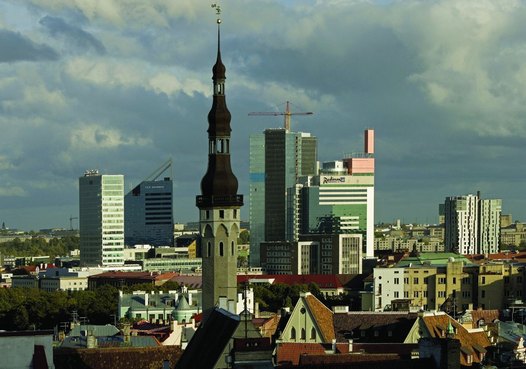Estonia, Latvia and Lithuania achieved their independence from the Soviet Union in 1991. The capital city of each country fortunately retained their historic 'old town' centres more or less intact. Characterising each was the medieval layout with narrow, winding streets, open-air markets and other public spaces and buildings of most types, styles and ages, all of which were low with a maximum of six floors.

Harmony or conflict? In the foreground Tallinn's old town showcasing the town hall tower. Behind it is the Maakri Quarter, the area defined as 'most suitable' for high-rise development in the city. Photo: Scanpix - Wojtek Buss
The exception was usually a large city centre hotel approximately twenty-stories high built in the 1960s or 1970s. For the rest, modern buildings were primarily housing with flats in the so-called 'Khrushchev' or 'Brezhnev' style further away from the city centres and sometimes reaching eight or ten floors in height. In Riga the Stalinist house of culture, the broadcasting house, the press centre and the television tower could all be added to the skyscraper endowment of the Soviet inheritance.
It would however be fair to say that 'high-rise' construction – at least in terms of building height - in these cities has historically meant the church, its bell tower or the watch tower of the castle. For Vilnius it is the 68m high bell tower of St. John's church (1571). For Riga it is the 123m high St. Peter's church spire (rebuilt with a steel skeleton between 1967 and 1983 after it was destroyed during World War II) and for Tallinn the 124m tall church of St. Olav's.
Old town centres represent history, tradition and also a greater potential to generate income from tourists and local residents. Just check the prices of apartments in such locations. Vilnius' 'old town' joined the UNESCO list of world heritage sites in 1994. Three years later Riga and Tallinn were also accepted into this prestigious group.
The charming structures make all three locations unmissable tourist destinations. Developers however are also attracted to these unique settings. In Vilnius this fascination began in 2000-01 with the first 33 floor commercial building which was completed in 2004. Almost 129 metres high the building was almost double the height of the previous highest in the locale, the church-tower of St. John's.
In the same year Riga saw the construction of the Hansa Bank (now Swed Bank) headquarters rising to 121 metres. In 2006 the 113 metre high Tomimae commercial centre was erected in Tallinn. Common to all is the possibility for the occupants to look down on the magnificent roofscapes of the historic buildings nearby.
Since all of these new "skyscrapers" were located in the so-called 'protection' or 'buffer-zones' allotted to the heritage sites, the new structures naturally generated a significant amount of discussion. Local grassroots activists and sections of the professional communities protested. UNESCO was, moreover, far from happy with this haphazard modernity. In particular, they were concerned about the impact on the skylines of the 'old town' centres.
In December 2006 an international conference was convened to discuss the issues in Vilnius. It was organised by city authorities and attracted key representatives from Riga and Tallinn as well as from UNESCO in a bid to halt the move towards eclecticism across the entire skyline of each city. The conclusions of the conference were:
• The economic necessityfor high-rises should undergo
feasibility studies with full cost analysis.
• Studies of silhouttes, viewpoints and urban morphology
should be undertaken before planning decisions were made
• The transparency of the process and the provision of information to citizens and to the World Heritage Committee should be improved.
To some degree all three cities have followed the recommendations.
In the Journal of Nordregio No2, 2009 we presented an overview of the Nordic capital's high-rise buildings and city densification. In this issue we examine current developments in a similar context in the three Baltic capitals. The various national analyses were undertaken by Janis Dripe, City Architect of Riga, Endrik Mänd Chief Architect of Tallinn and Gediminas Rutkauskas, Director of Vilnius Old Town Renewal Agency.

By Odd Iglebaek